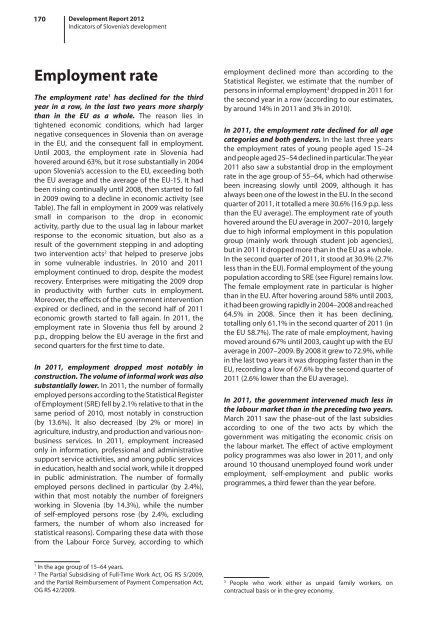development report 2012 - UMAR
development report 2012 - UMAR
development report 2012 - UMAR
You also want an ePaper? Increase the reach of your titles
YUMPU automatically turns print PDFs into web optimized ePapers that Google loves.
170 Development Report <strong>2012</strong><br />
Indicators of Slovenia’s <strong>development</strong><br />
Employment rate<br />
The employment rate 1 has declined for the third<br />
year in a row, in the last two years more sharply<br />
than in the EU as a whole. The reason lies in<br />
tightened economic conditions, which had larger<br />
negative consequences in Slovenia than on average<br />
in the EU, and the consequent fall in employment.<br />
Until 2003, the employment rate in Slovenia had<br />
hovered around 63%, but it rose substantially in 2004<br />
upon Slovenia’s accession to the EU, exceeding both<br />
the EU average and the average of the EU-15. It had<br />
been rising continually until 2008, then started to fall<br />
in 2009 owing to a decline in economic activity (see<br />
Table). The fall in employment in 2009 was relatively<br />
small in comparison to the drop in economic<br />
activity, partly due to the usual lag in labour market<br />
response to the economic situation, but also as a<br />
result of the government stepping in and adopting<br />
two intervention acts 2 that helped to preserve jobs<br />
in some vulnerable industries. In 2010 and 2011<br />
employment continued to drop, despite the modest<br />
recovery. Enterprises were mitigating the 2009 drop<br />
in productivity with further cuts in employment.<br />
Moreover, the effects of the government intervention<br />
expired or declined, and in the second half of 2011<br />
economic growth started to fall again. In 2011, the<br />
employment rate in Slovenia thus fell by around 2<br />
p.p., dropping below the EU average in the first and<br />
second quarters for the first time to date.<br />
In 2011, employment dropped most notably in<br />
construction. The volume of informal work was also<br />
substantially lower. In 2011, the number of formally<br />
employed persons according to the Statistical Register<br />
of Employment (SRE) fell by 2.1% relative to that in the<br />
same period of 2010, most notably in construction<br />
(by 13.6%). It also decreased (by 2% or more) in<br />
agriculture, industry, and production and various nonbusiness<br />
services. In 2011, employment increased<br />
only in information, professional and administrative<br />
support service activities, and among public services<br />
in education, health and social work, while it dropped<br />
in public administration. The number of formally<br />
employed persons declined in particular (by 2.4%),<br />
within that most notably the number of foreigners<br />
working in Slovenia (by 14.3%), while the number<br />
of self-employed persons rose (by 2.4%, excluding<br />
farmers, the number of whom also increased for<br />
statistical reasons). Comparing these data with those<br />
from the Labour Force Survey, according to which<br />
employment declined more than according to the<br />
Statistical Register, we estimate that the number of<br />
persons in informal employment 3 dropped in 2011 for<br />
the second year in a row (according to our estimates,<br />
by around 14% in 2011 and 3% in 2010).<br />
In 2011, the employment rate declined for all age<br />
categories and both genders. In the last three years<br />
the employment rates of young people aged 15–24<br />
and people aged 25–54 declined in particular. The year<br />
2011 also saw a substantial drop in the employment<br />
rate in the age group of 55–64, which had otherwise<br />
been increasing slowly until 2009, although it has<br />
always been one of the lowest in the EU. In the second<br />
quarter of 2011, it totalled a mere 30.6% (16.9 p.p. less<br />
than the EU average). The employment rate of youth<br />
hovered around the EU average in 2007–2010, largely<br />
due to high informal employment in this population<br />
group (mainly work through student job agencies),<br />
but in 2011 it dropped more than in the EU as a whole.<br />
In the second quarter of 2011, it stood at 30.9% (2.7%<br />
less than in the EU). Formal employment of the young<br />
population according to SRE (see Figure) remains low.<br />
The female employment rate in particular is higher<br />
than in the EU. After hovering around 58% until 2003,<br />
it had been growing rapidly in 2004–2008 and reached<br />
64.5% in 2008. Since then it has been declining,<br />
totalling only 61.1% in the second quarter of 2011 (in<br />
the EU 58.7%). The rate of male employment, having<br />
moved around 67% until 2003, caught up with the EU<br />
average in 2007–2009. By 2008 it grew to 72.9%, while<br />
in the last two years it was dropping faster than in the<br />
EU, recording a low of 67.6% by the second quarter of<br />
2011 (2.6% lower than the EU average).<br />
In 2011, the government intervened much less in<br />
the labour market than in the preceding two years.<br />
March 2011 saw the phase-out of the last subsidies<br />
according to one of the two acts by which the<br />
government was mitigating the economic crisis on<br />
the labour market. The effect of active employment<br />
policy programmes was also lower in 2011, and only<br />
around 10 thousand unemployed found work under<br />
employment, self-employment and public works<br />
programmes, a third fewer than the year before.<br />
1<br />
In the age group of 15–64 years.<br />
2<br />
The Partial Subsidising of Full-Time Work Act, OG RS 5/2009,<br />
and the Partial Reimbursement of Payment Compensation Act,<br />
OG RS 42/2009.<br />
3<br />
People who work either as unpaid family workers, on<br />
contractual basis or in the grey economy.
















